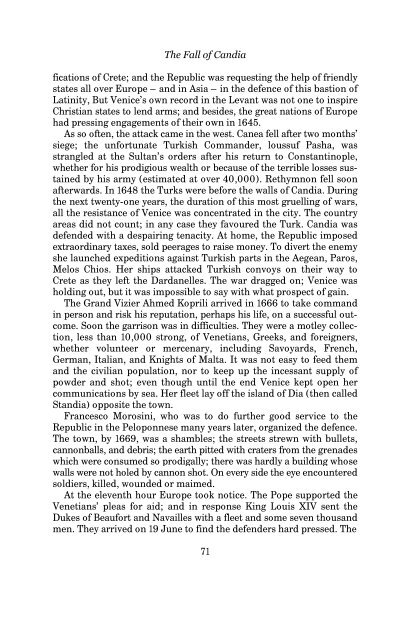free download here - Michael Llewellyn-Smith
free download here - Michael Llewellyn-Smith
free download here - Michael Llewellyn-Smith
Create successful ePaper yourself
Turn your PDF publications into a flip-book with our unique Google optimized e-Paper software.
The Fall of Candia<br />
fications of Crete; and the Republic was requesting the help of friendly<br />
states all over Europe – and in Asia – in the defence of this bastion of<br />
Latinity, But Venice’s own record in the Levant was not one to inspire<br />
Christian states to lend arms; and besides, the great nations of Europe<br />
had pressing engagements of their own in 1645.<br />
As so often, the attack came in the west. Canea fell after two months’<br />
siege; the unfortunate Turkish Commander, loussuf Pasha, was<br />
strangled at the Sultan’s orders after his return to Constantinople,<br />
whether for his prodigious wealth or because of the terrible losses sustained<br />
by his army (estimated at over 40,000). Rethymnon fell soon<br />
afterwards. In 1648 the Turks were before the walls of Candia. During<br />
the next twenty-one years, the duration of this most gruelling of wars,<br />
all the resistance of Venice was concentrated in the city. The country<br />
areas did not count; in any case they favoured the Turk. Candia was<br />
defended with a despairing tenacity. At home, the Republic imposed<br />
extraordinary taxes, sold peerages to raise money. To divert the enemy<br />
she launched expeditions against Turkish parts in the Aegean, Paros,<br />
Melos Chios. Her ships attacked Turkish convoys on their way to<br />
Crete as they left the Dardanelles. The war dragged on; Venice was<br />
holding out, but it was impossible to say with what prospect of gain.<br />
The Grand Vizier Ahmed Koprili arrived in 1666 to take command<br />
in person and risk his reputation, perhaps his life, on a successful outcome.<br />
Soon the garrison was in difficulties. They were a motley collection,<br />
less than 10,000 strong, of Venetians, Greeks, and foreigners,<br />
whether volunteer or mercenary, including Savoyards, French,<br />
German, Italian, and Knights of Malta. It was not easy to feed them<br />
and the civilian population, nor to keep up the incessant supply of<br />
powder and shot; even though until the end Venice kept open her<br />
communications by sea. Her fleet lay off the island of Dia (then called<br />
Standia) opposite the town.<br />
Francesco Morosini, who was to do further good service to the<br />
Republic in the Peloponnese many years later, organized the defence.<br />
The town, by 1669, was a shambles; the streets strewn with bullets,<br />
cannonballs, and debris; the earth pitted with craters from the grenades<br />
which were consumed so prodigally; t<strong>here</strong> was hardly a building whose<br />
walls were not holed by cannon shot. On every side the eye encountered<br />
soldiers, killed, wounded or maimed.<br />
At the eleventh hour Europe took notice. The Pope supported the<br />
Venetians’ pleas for aid; and in response King Louis XIV sent the<br />
Dukes of Beaufort and Navailles with a fleet and some seven thousand<br />
men. They arrived on 19 June to find the defenders hard pressed. The<br />
71


